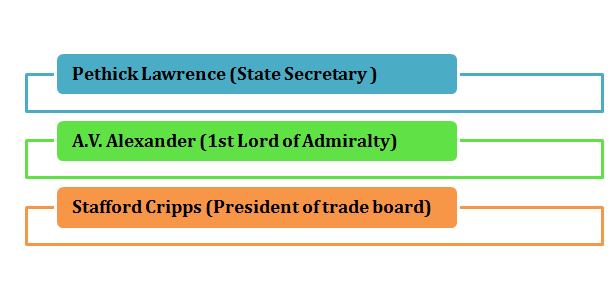

Atlee Government, the PM of Britain, introduced a highly powered mission for the transition of administration from the Britain Government to the Indian government. The cabinet’s mission was the discussion of the transition process. It failed as the National Congress of India did not follow the principles of this mission.
Clement Attlee introduced the cabinet mission by sending three British cabinet members The mission was approached for transferring the administrative power from the Britan government to Indian leaders (Sohal, 2017). The mission had a straightforward aim of giving independence to India and making the country’s people united. The members who are given the responsibility to control the mission are - Lord Pethick Lawrence, A V Alexander, and Sir Stafford Cripps.

Cabinet Mission’s Initial Members
The structure of the cabinet of British ruled India was three-tier. The Federal Union was at the highest tier. The province group was set in the middle tier and at the lowest tier, there were individual provinces. These groups were applied in India’s central, northwestern and eastern parts.
The British government realized that they were not being able to take administrative control over India. The need of uniting Indian people was clashing with Britain’s support for the Muslim League in a temporary manner. The united Indian subcontinent pushed the urge to unite India (Noorani, 2019). The British government was doubtful about Pakistan.
The wish for unity came with the result on the 24th of March 1946. The cabinet was initially formed by three British leaders. It was done to emphasize India after the country’s independence. The Muslim League and National Congress of India were ready for settlement at this stage and the election process used a different electoral system.
There were 90 Muslims out of 100 voters in the Muslim League and as a result of the surprising victory Jinnah earned the ability to make deals with Congress and the British. The government of Britain Could not make any changes due to the separated electorate system.
The Cabinet mission was purposed for the following objectives.
It was done so that Indian leaders could agree for establishing the Indian Constitution relating all society parts (Kazimi, 2019).
The mission was aimed at a committee formation bringing equal opportunities and respect for everyone as part of the Indian Constitution.
Cabinet mission was purposed to framing an Executive Council for supporting Indian bodies which are major in size.
The Cabinet Mission didn’t reach its goal due to the following reasons.
The Congress Party desired to keep the centre strong.
They didn’t wish to give power to provinces.
Making the Muslims politically strong was the desire of the Muslim League.
The opinion differences between the Muslim League and the Congress resulted in the mission approaching its plans. It was proposed that India would not be partitioned for its independence. The provinces would be categorized into three groups -A, B and C.
The Congress Party had no desire for province grouping on the Muslim-Hindu majority basis and wished to get central’s control. Any proposal changes although not desired by the Muslim League.
In the middle year 1946, a new mission was introduced to break India into two parts -one with a Hindu majority and the other with a Muslim majority.
The second proposal was not accepted by Jawaharlal Nehru’s Congress Party. Rather they agreed to bring it under constituent assembly.
An interim government was formed by fourteen men with the viceroy’s invitation. It was formed with equal members from Congress and Muslim League along with four other members.
The leaders of congress had taken entry to the interim council of the viceroy with Nehru’s approach to the interim government.
The Muslim League and Indian congress party had their initial acceptance of the Cabinet Mission. Congress did not accept the grouping structure. They were well concerned about religion-based province grouping. On the other hand, the Muslim League had not wanted any plan change, so an opinion difference eventually occurred. Any reconciliation attempts additionally made for the Cabinet Mission failed. As a result of an interim government was established. The Muslim League denied to stay as a common part and a large violence occurred in the country.
The Cabinet Mission significantly influenced the Constituent Assembly deliberations. It was emphasized in Nehru’s federalism and resolution of objectives (Venkatraman, 2019). The plan creation was acknowledged by the assembly. The assembly wished to follow the plan principles by legitly maintaining all duties and giving the Muslim League the option to be attached to its proceedings. At this stage, the assembly declared that the legitimacy was retrieved from the Indian people and not from the mission plan.
British PM Clement Attlee introduced the Cabinet mission in the year 1946. The mission was initiated by three British leaders to make unity of people in India for Indian Independence. The grouping structure was introduced in the Cabinet mission. It also expressed the division of provinces based on A, B or C groups. The goal of the cabinet mission was to shift the administrative responsibilities from British leaders to the leaders of India. It was purposed for Indian independence.
Q.1. How the provinces were proposed to be divided according to the Cabinet mission?
Ans. The provinces were proposed to be divided into three groups -A, B and C. Group A would include Orissa, Bihar, Bombay, UP, Central Provinces, and Madras. NWFP, Sindh, Punjab and Baluchistan would be included in group B. Assam and Bengal would be in group C.
Q.2. Who introduced the cabinet mission and in which year?
Ans. The Cabinet mission was introduced by Britain’s PM Clement Attlee. It was introduced in the year 1946.
Q.3. Why Cabinet mission was introduced?
Ans. Cabinet mission was introduced for the formation of the Indian constitution and formulation of the Indian Constituent Assembly. It was for the creation of an executive council where major Indian parties can cooperate.